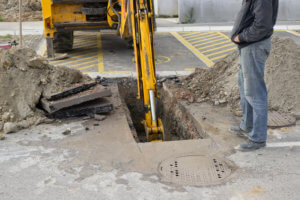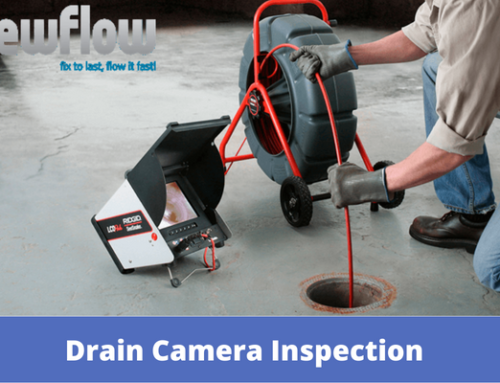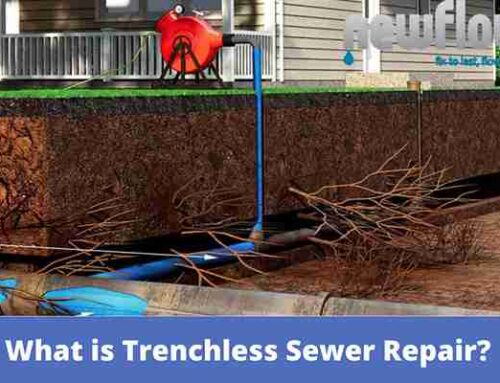What is Trenchless Sewer Repair?
Trenchless technology only involves finding two access points. For example, we can dig one 4ft by 4ft pit for one and remove a toilet for the other. There are two different options for how we can replace your pipes below. But before we go into that, see how trenchless technology is better than conventional methods, and how we at New Flow Plumbing have mastered the craft.

Is Trenchless Sewer Repair Better?
Conventional sewer line repair can involve tearing up your yard, ripping apart floors and walls inside your home, and can take days to complete. When that’s done, you’re left with the cost of replacing and repairing all the damage to your property.

Trenchless Sewer Pipe Lining
Note: The pipe’s diameter does become slightly smaller but it increases your new pipe’s flow capacity.
Read also: Does trenchless pipe replacement work?
Pipe Bursting
- Again, we perform a CCTV inspection and see how the pipe is holding up. We make sure we are not able to use pipe lining.
- Next, we find our two access points, one on each end of the pipe, typically in your yard.
- The brand new HDPE (high-density polyethylene) pipe is attached to a winch with a cone-shaped bursting head and pulled through the damaged pipe. The damaged pipe is broken apart as the new pipe takes its place.
- We perform another CCTV inspection to ensure everything is completed and then fill in any pits or reinstall any fixtures we removed.
This is an environmentally-friendly process that involves no chemicals.
Can All Pipes Be Repaired Using Trenchless Technology?
This method can be used for cracked, corroded, leaky, or misaligned pipes. If they’re under homes, commercial buildings, or landscaping that you do not want to be torn up, trenchless technology can take care of it! We can also fix any vertical stacks in multi-story buildings and lateral lines that connect to a city sewer or septic tank.
When it’s impossible to use a trenchless repair, we use conventional sewer replacement methods
Nonetheless, contact us and we can find the solution that works for you!
How Much Does Trenchless Sewer Repair Cost?
Trenchless sewer repair typically saves property owners between 30-40% of their entire project cost.

Trenchless sewer repair quotes may be anywhere from 30-50% more than the conventional sewer repair methods, but it is still a cost-effective solution because we do not destroy your property to get to the pipe. This means we save you thousands of dollars on restoration and clean up costs.
Whatever solution is needed, we at New Flow Plumbing can find your problem and fix it in no time!
FAQs
A sewer line backup happens when something blocks the flow of wastewater from your home to the city’s main sewer system. The most common causes are:
• Tree roots: They naturally grow toward moisture and can slip into tiny cracks in your pipes. Once inside, they expand and block the flow completely.
• Grease and oil: When poured down the sink, grease hardens inside the pipe and traps other debris.
• Foreign materials: Items like wipes, tissues, or paper towels don’t break down easily and can create stubborn clogs.
• Pipe damage: Old or corroded pipes may collapse or shift over time, leading to backups.
To prevent backups, avoid flushing anything other than toilet paper and have your sewer line inspected regularly to detect root or buildup problems early.
A clogged sewer line usually affects your entire home’s plumbing system—not just one drain. Common warning signs include:
• Multiple slow drains in sinks, tubs, or showers
• Gurgling noises from drains or toilets after flushing
• Unpleasant odors from drains or floor cleanouts
• Water backups in the bathtub when using the washing machine or sink
If you notice any of these symptoms together, the main sewer line is likely blocked. Acting quickly can prevent sewage from backing up into your home and damaging floors, walls, and furniture.
If you see or smell sewage coming back into your home, take these steps immediately:
1. Stop using all water in the house to prevent more backup.
2. Avoid flushing toilets or running taps, as that adds pressure to the blockage.
3. Keep people and pets away from the affected area because sewage can contain harmful bacteria.
4. Call a licensed plumber right away. Professionals have specialized tools to clear blockages safely without damaging your pipes.
Delaying this repair can lead to serious health hazards and expensive cleanup, so it’s best to act fast.
Grease buildup is one of the easiest plumbing problems to prevent if you follow a few habits:
• Never pour grease, oil, or fat down the sink. These substances harden as they cool, sticking to pipe walls.
• Let grease cool first, then scrape it into a sealed container and throw it away in the trash.
• Wipe pans and plates with a paper towel before washing them to remove leftover oils.
• Use strainers in your kitchen sink to catch food debris that could stick to grease.
Following these habits will help your drains stay clear and extend the life of your plumbing system.
No, it’s not safe or effective in the long run. Chemical drain cleaners and bleach may provide short-term relief but can cause serious long-term damage:
• They corrode metal pipes and eat through old seals or joints.
• They can weaken PVC pipes, making them prone to cracking.
• The fumes can be harmful to your health, especially in poorly ventilated areas.
Instead, use natural enzyme-based cleaners or contact New Flow Plumbing, which uses professional tools and eco-friendly methods to clear clogs safely without damaging your plumbing.
Most homeowners should have their sewer lines inspected once every 12 to 18 months. However, you may need more frequent checks if:
• Your home is over 30 years old.
• You have large trees near the sewer line.
• You’ve had frequent clogs or slow drains.
During an inspection, plumbers use a sewer camera to check for cracks, root intrusions, or buildup. Detecting issues early can save thousands of dollars in future repairs.
A damaged sewer line often gives warning signs long before it fails completely. Watch for:
• Persistent slow drains across multiple fixtures
• Gurgling noises when you flush or drain water
• Foul odors coming from drains or your yard
• Wet spots or sinkholes in the lawn
• Higher water bills due to hidden leaks
If you notice these symptoms, schedule a professional inspection as soon as possible. Companies like New Flow Plumbing can perform a video inspection to pinpoint the damage and recommend cost-effective repair options.
Yes. Tree roots are naturally drawn to the moisture and nutrients found in sewer lines. They can sneak through even the smallest cracks or loose joints, then spread rapidly inside the pipe. Once inside, they trap toilet paper and debris, leading to severe clogs.
To prevent this:
• Keep trees planted at least 10–15 feet away from your sewer line.
• Choose tree species with less aggressive root systems.
• Schedule regular sewer camera inspections to detect early root growth before it becomes a full blockage.
Repairing may not be enough when your sewer line shows signs of extensive damage or repeated failure. Replacement is often necessary if:
• The pipe is collapsed or severely cracked.
• You’re experiencing frequent clogs even after cleaning.
• There’s visible damage or shifting from ground movement.
• Your system is made of outdated materials like clay or cast iron.
Modern trenchless replacement methods let professionals replace damaged sections without digging up your entire yard, saving both time and landscaping costs.
Sewer issues are complex and not something homeowners can fix with basic tools. Professional plumbers have the right equipment, experience, and safety training to solve the problem properly. They can:
• Use video inspections to locate blockages or breaks accurately.
• Perform hydro jetting to clear out roots, grease, and debris.
• Recommend long-term solutions like trenchless repairs or replacements.
Working with experts such as New Flow Plumbing ensures your sewer system is cleaned, repaired, or replaced safely and effectively—preventing repeat issues and protecting your home from costly damage.

Arman Grigoryan
Founder & President of New Flow Plumbing
Arman Grigoryan is the founder and president of New Flow Plumbing, proudly serving Los Angeles, Sacramento, and surrounding areas. With extensive experience in plumbing diagnostics, he leads a skilled team specializing in advanced sewer and drain camera inspections to quickly identify problems and deliver lasting solutions. Arman is dedicated to using the latest technology to provide reliable service, honest answers, and dependable results for every customer.






